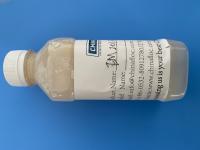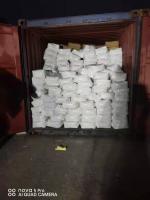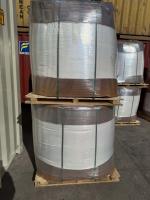Our Products
Polyacrylamide / cationic polyacrylamide hydrex 6316 can be replaced by Chinafloc C1012

hydrex 6316 is a high molecualr weight ,low charge cationic polyacrylamide that is used as flocculant or coagulant aid in a wide variety of mining,municipal and industrial water and wastewater treatment applications
Cationic polyacrylamide (Hydrex 6316) is a high-efficiency flocculant and coagulant developed by Veolia Water Technologies under its Hydrex 6000-series polymer product line. It is a water-soluble, high-molecular-weight cationic polymer designed for use in solid–liquid separation, wastewater clarification, sludge dewatering, and process water treatment across many industrial sectors. The product provides exceptional performance in systems where fine suspended solids, organic matter, and colloidal particles must be efficiently removed to produce clear water and manageable sludge.
Hydrex 6316 is classified as a cationic polyacrylamide (CPAM) with high molecular weight and moderate cationic charge density. The polymer chain contains cationic functional groups derived from quaternary ammonium compounds, which provide strong electrostatic attraction toward negatively charged suspended particles. The resulting flocs are large, dense, and stable, which enables faster sedimentation, clearer supernatant, and improved filtration or centrifugation efficiency. Because of its strong positive charge, Hydrex 6316 effectively bridges and neutralizes anionic impurities, making it particularly suitable for wastewater from food processing, papermaking, textile, chemical, and municipal treatment plants.
1. Application in municipal and industrial wastewater treatment
Hydrex 6316 is widely used in primary and secondary clarification stages of wastewater treatment. In primary treatment, it serves as a coagulant aid to promote the aggregation of suspended solids and colloidal matter, thereby improving the removal of turbidity, oils, fats, and organic impurities. When combined with inorganic coagulants such as alum, ferric chloride, or polyaluminum chloride (PAC), the cationic polymer enhances floc formation and strengthens the overall coagulation process. This results in a more compact sludge with faster settling velocity and reduced sludge volume.
In secondary or biological treatment systems, Hydrex 6316 assists in the clarification of biological sludges and effluents. Activated sludge systems often suffer from poor settling due to the presence of light or filamentous flocs; the cationic polyacrylamide neutralizes excess negative surface charges on biomass flocs, enabling better compaction in secondary clarifiers. This reduces sludge blanket height and improves the quality of the clarified effluent, lowering total suspended solids (TSS) and biochemical oxygen demand (BOD).
Another key area of application is sludge thickening and dewatering. Waste activated sludge or digested sludge usually contains a high proportion of water (95–99%). Hydrex 6316 is dosed prior to mechanical dewatering devices such as belt filter presses, centrifuges, and screw presses. The polymer promotes floc formation and improves water release, resulting in drier cakes with lower moisture content. This not only minimizes disposal cost but also enhances throughput of dewatering equipment. In some cases, the polymer can reduce the need for inorganic conditioners such as lime or ferric salts, thereby lowering chemical costs and improving the quality of filtrate water.
2. Application in the paper and pulp industry
In the papermaking process, Hydrex 6316 is used as a retention and drainage aid, fixative, and defoamer aid. It increases the retention of fine fibers, fillers, and pigments on the forming wire, improving paper strength and quality while reducing losses in white water. The cationic charge of the polymer effectively neutralizes anionic trash—such as lignin sulfonates, resin acids, and anionic dispersants—allowing other cationic additives like starch and dyes to work more efficiently.
By improving drainage on the paper machine, Hydrex 6316 reduces drying energy consumption and enhances production speed. It also stabilizes the wet-end system by controlling charge balance and reducing pitch and stickies deposition on machinery. Compared with inorganic coagulants, the use of this organic polymer decreases corrosion and sludge formation, leading to cleaner, more stable operations and consistent paper quality.
3. Application in oilfield and petrochemical processes
Hydrex 6316 also finds important applications in oilfield wastewater and produced water treatment. During crude oil extraction and refining, emulsified oil and suspended solids must be separated from water before reuse or disposal. The cationic polyacrylamide acts as a flocculant to destabilize oil–water emulsions by neutralizing the negative charges on oil droplets and colloidal impurities. This leads to rapid coalescence and separation of oil from water, producing a clear effluent with very low oil content.
In enhanced oil recovery (EOR) and drilling operations, Hydrex 6316 is used for the clarification of injection water, treatment of spent drilling mud, and separation of solids in produced fluids. Its stability under a wide range of pH, salinity, and temperature conditions allows it to perform effectively even in challenging offshore and onshore field environments. By improving water clarity and reducing fouling, it enhances process efficiency and protects downstream equipment.
4. Application in mining and mineral processing
In the mining industry, Hydrex 6316 is used in solid–liquid separation, tailings management, and process water recycling. Mineral processing operations generate large volumes of fine tailings and slurries that are difficult to settle or filter. The cationic polyacrylamide flocculates negatively charged mineral particles, accelerating sedimentation and enabling thickening and filtration.
In thickener applications, it improves underflow solids concentration while maintaining clear overflow water suitable for reuse in the process circuit. In tailings dewatering, it enhances water recovery and reduces the footprint of storage ponds. The polymer is also compatible with anionic flocculants and inorganic coagulants, allowing for customized treatment programs that optimize performance based on ore type and slurry chemistry.
5. Application in textile, chemical, and food industries
Hydrex 6316 is commonly used in textile dyeing wastewater to remove color and suspended solids. The cationic polymer breaks dye–fiber bonds and forms flocs with dissolved dye molecules, enabling rapid decolorization and sedimentation. In the food and beverage industry, it assists in clarifying process water and wastewater containing organic solids such as starch, proteins, and fats. In chemical manufacturing, it is employed in clarifying process streams and recovering valuable solids.
Because it is highly soluble and effective at low dosages, Hydrex 6316 offers excellent operational flexibility and cost-effectiveness. It can be dosed continuously or intermittently, depending on process conditions, and it works efficiently across a broad pH range (typically 4–9).
6. Advantages and performance characteristics
Hydrex 6316 provides several performance benefits compared with conventional inorganic coagulants or lower-molecular-weight polymers:
-
High molecular weight: ensures long polymer chains that create strong bridging between fine particles.
-
Moderate cationic charge density: provides efficient charge neutralization without excessive polymer demand.
-
Rapid floc formation: produces large, fast-settling flocs that improve clarification and filtration rates.
-
Low sludge volume: generates denser, easier-to-dewater sludge compared with metal salt coagulants.
-
Wide application range: effective in municipal, industrial, and process water systems.
-
Compatibility: can be used alongside other polymers or coagulants to achieve optimal results.
7. Typical usage and handling
Hydrex 6316 is supplied as a dry powder or emulsion concentrate, typically containing 20–50% active polymer. It is diluted with clean water to prepare a 0.1–0.5% solution before dosing. The product should be added at points of good mixing to ensure even distribution. Dosage levels vary according to system characteristics, usually between 1–20 mg/L for clarification and 2–10 kg/ton of dry solids for dewatering.
Proper storage and preparation are essential to maintain polymer performance. The product should be stored in cool, dry conditions away from heat and sunlight. Solutions should be prepared using non-metallic equipment and used within 24 hours to prevent hydrolysis.
Conclusion
Cationic polyacrylamide (Hydrex 6316) is a versatile, high-performance flocculant that plays a critical role in modern water and wastewater management. Its applications span from municipal water clarification to industrial sludge dewatering, papermaking, oilfield water treatment, and mineral processing. By efficiently binding and aggregating fine particles, Hydrex 6316 improves water quality, reduces sludge handling costs, and enhances process reliability. Its wide adaptability, strong cationic activity, and environmental compatibility make it one of the most effective and widely used flocculants in the Hydrex 6000 series and a vital component of sustainable industrial water treatment operations worldwide.





